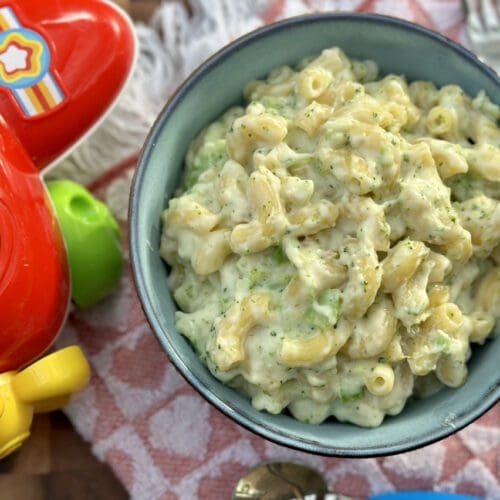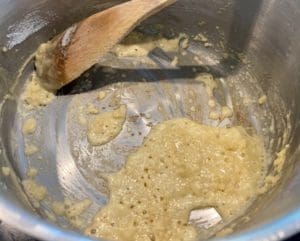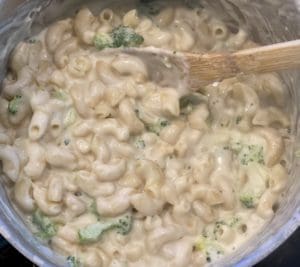
Mac and Cheese for baby
This Mac and Cheese for Baby will please the fussiest eater. It's tastier, healthier and less processed than store-made versions!
Ingredients
- 20 gm butter
- 1 clove garlic (minced)
- 1½ tbsp plain flour (all-purpose flour)
- 2 cup milk
- 2 cup water
- 1½ cup dried macaroni pasta (elbows) (NOTE 1)
- 1 tsp onion powder (NOTE 2)
- ¼ tsp salt (NOTE 3)
- ½ cup chopped broccoli (NOTE 4)
- ½ cup grated mozzarella cheese (NOTE 5)
Instructions
- Melt the butter in a medium saucepan over medium heat. Add in garlic and stir quickly for a few seconds until fragrant, then add in the flour, stirring quickly for a minute. Once the mixture bubbles slowly pour in the milk, whilst whisking. It'll look lumpy at first but continue to whisk until smooth. Once the milk is hot, pour in the water and bring it to a boil.

- Add in the macaroni, broccoli, onion powder and salt (if using), stir regularly for 10 to 15 or until the pasta and broccoli have softened. Stir regularly, so the pasta doesn't get stuck to the bottom of the pan. The Mac and cheese should look saucy, don't overcook it or it'll become too dry. Stir in the cheese until it has completely melted. The sauce will thicken more once the pasta cools down.

Notes
(NOTE 1) Macaroni (elbows) - These days there are many healthier pasta varieties available to us! Supermarkets have veggie, fibre pasta, buckwheat, wholemeal pasta and many more. All these kinds of pasta will work, however, stick to the elbows or smaller macaroni, as they're quicker to cook over the stove.
(NOTE 2) Onion powder - Always take the time to read the ingredients list on the label. The onion powder I used states that 'it may contain traces of sesame' which is a common food allergy. Dried parsley or any herbs and spices are good substitutions.
(NOTE 3) Salt - Please adjust the salt to the needs of your child. If your child is younger than 12 months, you may wish to skip adding salt altogether.
(NOTE 4) Broccoli - I've tried cooking with lots of different veggies with Kai's Mac and Cheese. For us, he would always eat it if it's with broccoli, just as long as I don't place too much of it in. You may swap broccoli for a veggie your child would eat, such as corn, carrots, or zucchini. Chop the vegetable in safe sizes for your little one to prevent choking.
(NOTE 5) Mozzarella cheese - I used mozzarella cheese as it's mild in taste and relatively low in fat and calories. It's also a healthier option compared to other types of cheese. However, any kind of melting cheese would work, such as mild cheddar.
Leftovers - Allow the pasta to cool completely at room temperature. Transfer the pasta into an airtight container and refrigerate, it'll be good for up to 3 days. Frozen pasta will keep for up to 3 months.
Cooking measurements are in Australian standard spoon and cup measurements.
A Third-Party Application calculated the calories and nutritional information. Please use this as an approximate guide only.
Nutrition
Serving: 1servingCalories: 182kcalCarbohydrates: 24gProtein: 7gFat: 6gSaturated Fat: 3gPolyunsaturated Fat: 1gMonounsaturated Fat: 2gTrans Fat: 1gCholesterol: 17mgSodium: 167mgPotassium: 168mgFiber: 1gSugar: 4gVitamin A: 244IUVitamin C: 5mgCalcium: 117mgIron: 1mg